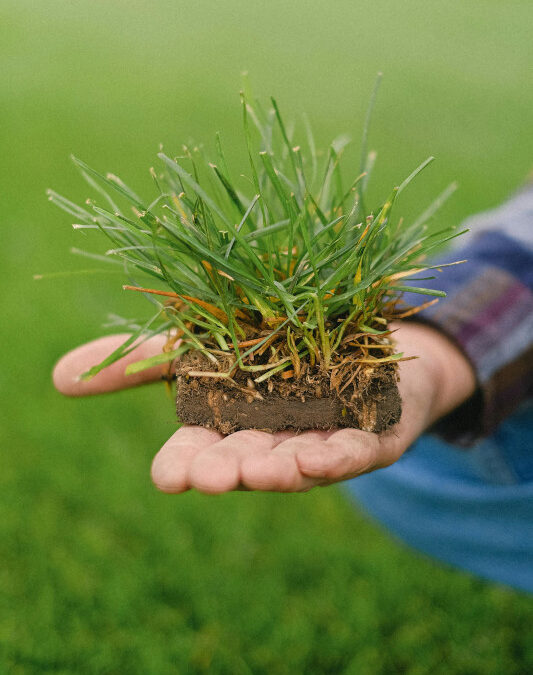Planning Ahead: Why Proper Prep Pays Off
The Importance of Accurate Measurement and Site Prep
Thinking about transforming your lawn with new sod? Smart move. But before the first roll hits the ground, there’s one crucial step you don’t want to overlook: preparation. Accurate measuring and site prep can save you time, money, and headaches — and it ensures your investment in a healthy, beautiful lawn pays off long-term.
What to Expect from Your Sod Installation Appointment
If you’re hiring a professional installer like Henry Landscaping, our team will guide you through the process — but a little prep on your end can help everything run smoother. Knowing your lawn’s dimensions, prepping the site, and having basic info ready can help speed up your estimate, reduce waste, and get your new lawn growing faster.
Step-by-Step Guide to Measuring Your Yard
Tools You’ll Need (and Optional Online Calculators)
Don’t worry — measuring your lawn doesn’t require high-tech gear. All you need is:
- A measuring tape or measuring wheel
- Paper and pencil (or a phone note app)
- A calculator (or use an online sod calculator)
You can also find free online tools that help calculate square footage based on shape — just search for “sod calculator” and input your dimensions.
How to Measure Squares, Rectangles, Circles & Odd-Shaped Areas
Break your lawn into manageable zones:
- Rectangles & Squares: Measure length × width = square footage
- Circles: Measure the radius and use the formula π × r²
- Triangles: Measure base × height ÷ 2
- Odd Shapes: Break them into smaller sections of known shapes, then add it all together
Don’t forget to subtract areas like patios, driveways, or decks where sod won’t go.
Adding a Buffer: Why You Should Order Extra Sod
It’s a smart move to order 5–10% more sod than your calculated area. This accounts for trimming, cutting around curves or obstacles, and any mismeasurements. It’s always better to have a few extra rolls than come up short halfway through the job
How to Calculate How Much Sod You’ll Need
Converting Square Feet to Sod Rolls or Pallets
Most sod is sold by the pallet, with each pallet covering roughly 450–500 square feet, depending on the supplier and grass type. Divide your total square footage by the coverage amount per pallet to determine how many pallets you’ll need. For smaller areas, sod may be sold in rolls — each typically covering about 8–10 square feet.
Dealing with Slopes and Irregular Terrain
If your yard includes hills or slopes, add a little extra to account for the rise in elevation. Sod laid on slopes often requires tighter overlap and custom cutting, which uses more material. It’s a good idea to flag these areas during your walkthrough or estimate to avoid surprises.
Preparing the Site Before Installation Day
Clearing the Area: Grass, Weeds, and Debris
Before sod can be installed, the existing lawn needs to be removed. This includes grass, weeds, and any surface debris like sticks, stones, or leftover mulch. You can rent a sod cutter or ask your installer to handle this step — just be sure the ground is cleared to bare soil before new sod arrives.
Leveling, Grading, and Fixing Drainage Issues
Next, ensure your soil is level and drains well. Low spots should be filled in, and any standing water issues addressed before sod is installed. A slight grade away from your home helps prevent water from pooling around the foundation. Grading also helps ensure your new lawn looks even and professional once it’s complete.
Soil Testing and Amendments (Fertilizer, Lime, Compost)
Healthy soil is the foundation of a healthy lawn. A simple soil test will tell you the pH and nutrient levels so you can amend it properly. In Charleston, we often recommend:
- Starter fertilizer for root development
- Lime to raise pH in acidic soils
- Compost or topsoil to improve structure and drainage
If you’re working with Henry Landscaping, we’ll handle this step for you — but it’s always helpful to know what’s going into your yard.
Working With a Professional Sod Installer
Information to Have Ready for Your Estimator
When scheduling a sod installation estimate, it helps to have the following ready:
- Approximate square footage of your lawn
- Photos or videos of your yard (if remote consultation)
- Any concerns like drainage, shade, or heavy use areas
The more info you can provide up front, the faster and more accurately we can plan your project.
What You Can DIY vs. What the Pro Will Handle
Want to cut costs? Some homeowners choose to handle clearing and soil prep themselves, then hire professionals for sod delivery and installation. Others prefer a full-service approach — we show up, prep the soil, lay the sod, and leave you with a lush new lawn and care instructions.
Why Professional Installation Sets You Up for Long-Term Success
Professionals understand how to grade properly, select the right sod type, install it seamlessly, and water it in for maximum root contact. A poorly installed lawn may look fine on day one, but problems like gaps, poor drainage, or lifting turf show up quickly. Hiring a team like Henry Landscaping means peace of mind and long-lasting results.
Conclusion
Get the Job Done Right from the Start
Whether you’re planning to DIY parts of your lawn transformation or want a professional to handle everything, measuring and prepping correctly is the first step toward success. It ensures you get the right amount of sod, avoid delays, and set the stage for a healthy lawn that thrives from day one.
Book a Sod Estimate with Henry Landscaping
Ready to roll out a beautiful new lawn? Contact Henry Landscaping for a professional estimate. We’ll help you measure, prep, and install with precision — so all you have to do is kick back and enjoy your fresh green space.
Related Articles
The Pros and Cons of Sod Installation vs. Seeding Your Lawn
Hello! Let’s talk grass. Grass is everywhere.MOST places it’s growing wild. Fields, farms,...
Tips for Sod Installation and Maintenance
Tips for Sod Installation and Maintenance Preparing the Ground for Sod Assess Your Yard Identify...
Factors to Consider When Choosing Sod for Your Area
Factors to Consider When Choosing Sod for Your Area There are many factors that go into...
Choosing the Right Type of Sod for Your Climate
Needing to choose the right kind of sod for your yard may not be something you considered to be a...

